My hands are still cold from the experience, but there’s no denying the pleasure I felt at seeing C/2013 R1 Lovejoy and C/2012 X1 LINEAR through the telescope this morning. Some comets fizzle, others fall apart, but these vaporous hunks have hung in there for months like steadfast friends that stick with you through hard times and good.While no longer visible with the naked eye, 50mm binoculars easily show it as a magnitude 7 fuzzy glow with a short, faint tail pointing up and away to the northwest. I had no difficulty seeing it even with a last quarter moon glaring in the south.
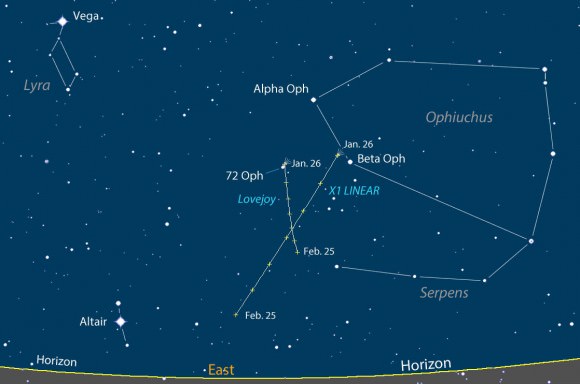
Rising around 3 a.m., Lovejoy is best placed for viewing just before the start of dawn when it climbs to about 30 degrees altitude in Ophiuchus. Lucky for us, Lovejoy will spend the next few mornings very close to the easy naked eye star 72 Ophiuchi, located 3 fists held at arm’s length to the lower right of brilliant Vega. It’s not often that a fairly bright comet passes this close to a helpful guide star. Don’t miss this easy catch. Soon the moon won’t be any trouble either as it skedaddles eastward and dwindles to a crescent in the coming mornings.
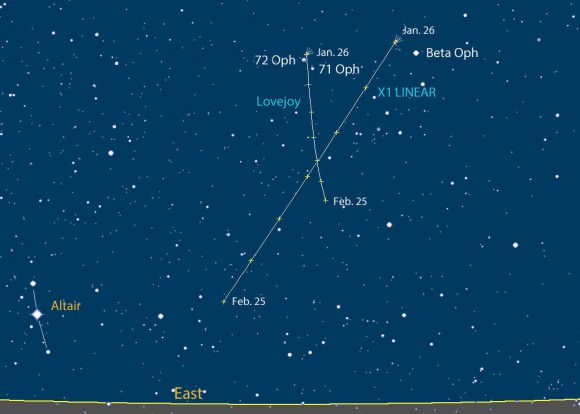
Telescopic views of Lovejoy show a much diminished coma and tail compared to its heyday in early December. Still, the nucleus remains bright and very condensed within the 3′ diameter gauzy coma; a faint and silky tail 2/3 of a degree long flowed across the field of view of my 15-inch (37-cm) reflector like a bride’s train. According to the excellent Weekly Information about Bright Comets site maintained by Seiichi Yoshida, Lovejoy should glow brighter than magnitude 8, what I consider the “bright” comet cutoff, through early February. Given that Lovejoy remains the brightest predicted comet visible till summer, show it some love the next clear night.
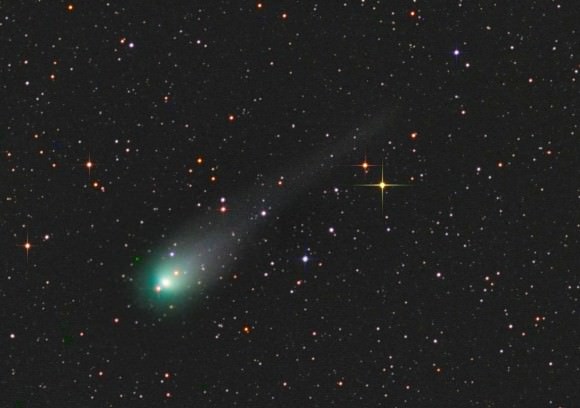
If Lovejoy’s a fading celebrity, X1 LINEAR suffered a mid-life crisis and snapped out of it with a whole new attitude. Like Comet Holmes in 2007, it catapulted in brightness overnight in last October, blossoming from a 14th magnitude blip into a bright, expanding puffball briefly visible in ordinary binoculars. As expected, the comet soon faded. But on its return to obscurity, X1 surprised again, re-brightening and growing a short tail. Now it’s humming along at 9th magnitude thank you very much. You’ll find it gliding across northern Ophiuchus not far from Lovejoy (more about that in a minute).
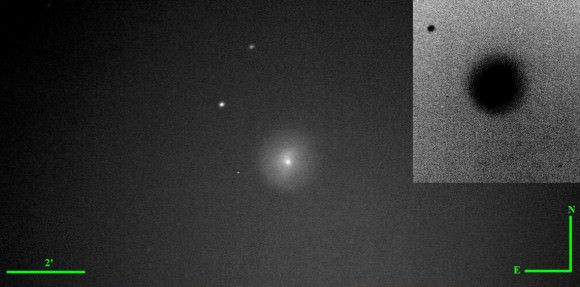
My binoculars won’t show the comet but a 6-inch telescope will do the trick. Overall weaker in appearance than Lovejoy, X1 LINEAR has a slightly larger, more diffuse coma, brighter core and a short, faint tail pointing to the northwest. The comet will remain a fine target for smaller scopes through early March when it’s predicted to glow between magnitude 8 and 9.
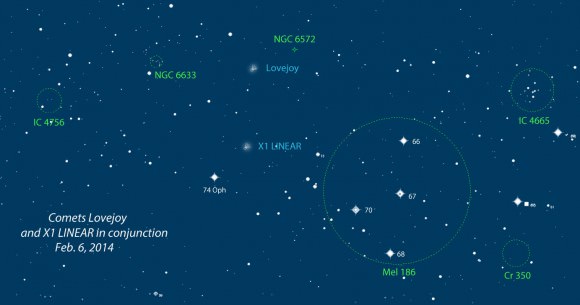
Looking at the maps, you’ll see that our two comets’ paths intersect. While they won’t overlap on the same morning, Lovejoy and X1 LINEAR will be in conjunction on Feb. 6 when they’ll be just 2 degrees apart. Get that camera ready! Guided telephoto and wide-field telescopes will be perfect for catching this unusual duet.
Before I sign off, don’t forget all the other good morning stuff: Mars hovers above Spica high in the south-southwestern sky, Saturn invites inspection in the southeast and Venus is back in view in the east-southeast 45 minutes before sunup. A delicate crescent moon shines near Venus on Jan. 28 and 29. Such riches.

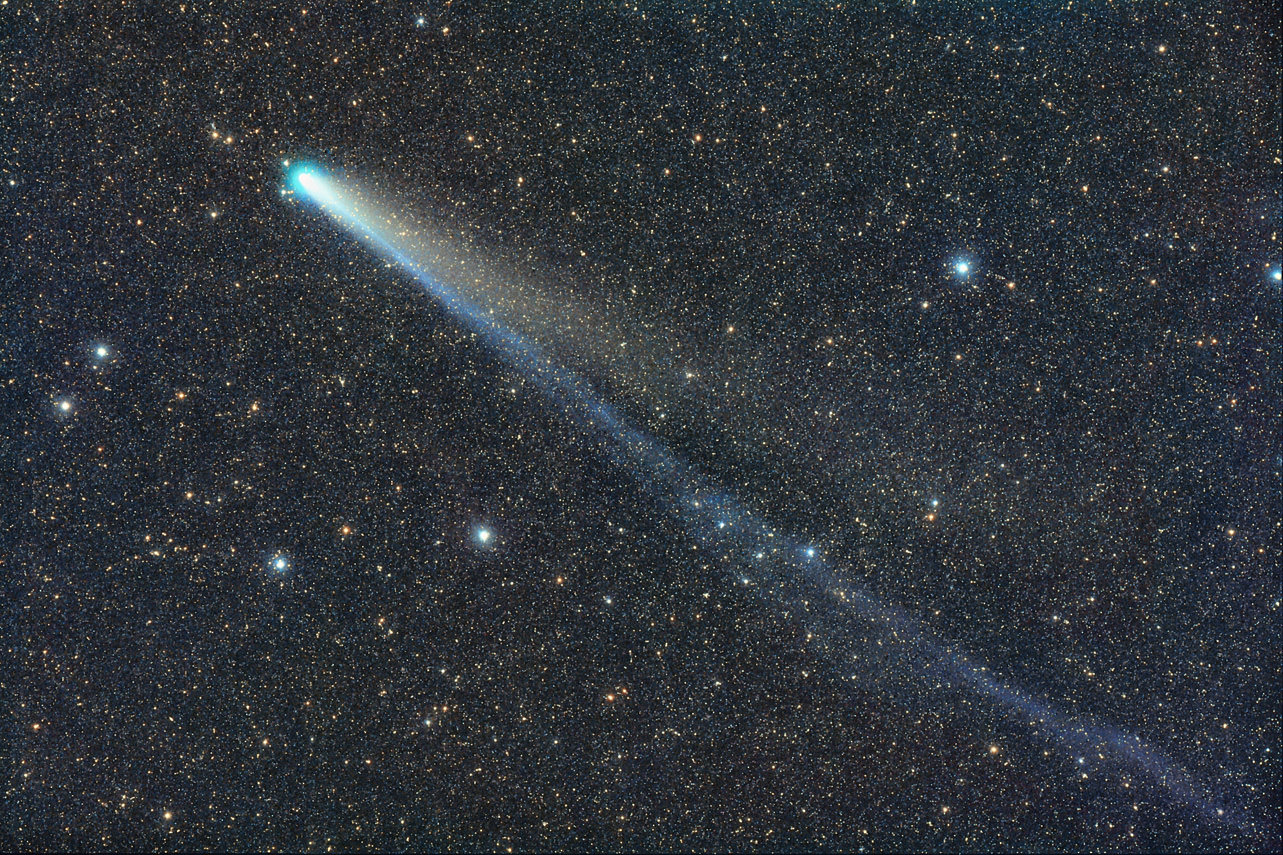
Thanks for the inspiration Bob! i printed star charts for both comets and tomorrow morning is looking good for some viewing. IF I catch Comet LINEAR, I will have seen total of 49 comets. And I’d love to see Comet Lovejoy again… (#48) a welcome respite after Comet ISON’s (#47) disheartening apparition.
Clouded out…. dzz
I have been observing comets for 40 years (Kohoutek was the first) and have logged a total of 128. This morning I was able to see the two comets in the same telescopic field of view, a 120 mm f/5 refractor at . This was something I’d never done before and it ranks right up there with seeing five comets in one night (twice, the 2nd time being this past Nov) and seeing Hale-Bopp and Kopff in the same binocs field of view (6/7/96). (Actually, Mrkos was the first one I saw, but my grandfather showed it to me when I was 10, so I don’t count it in “my years” of observing.)
Two comets at the same time in the eyepiece is so rare. Congratulations!